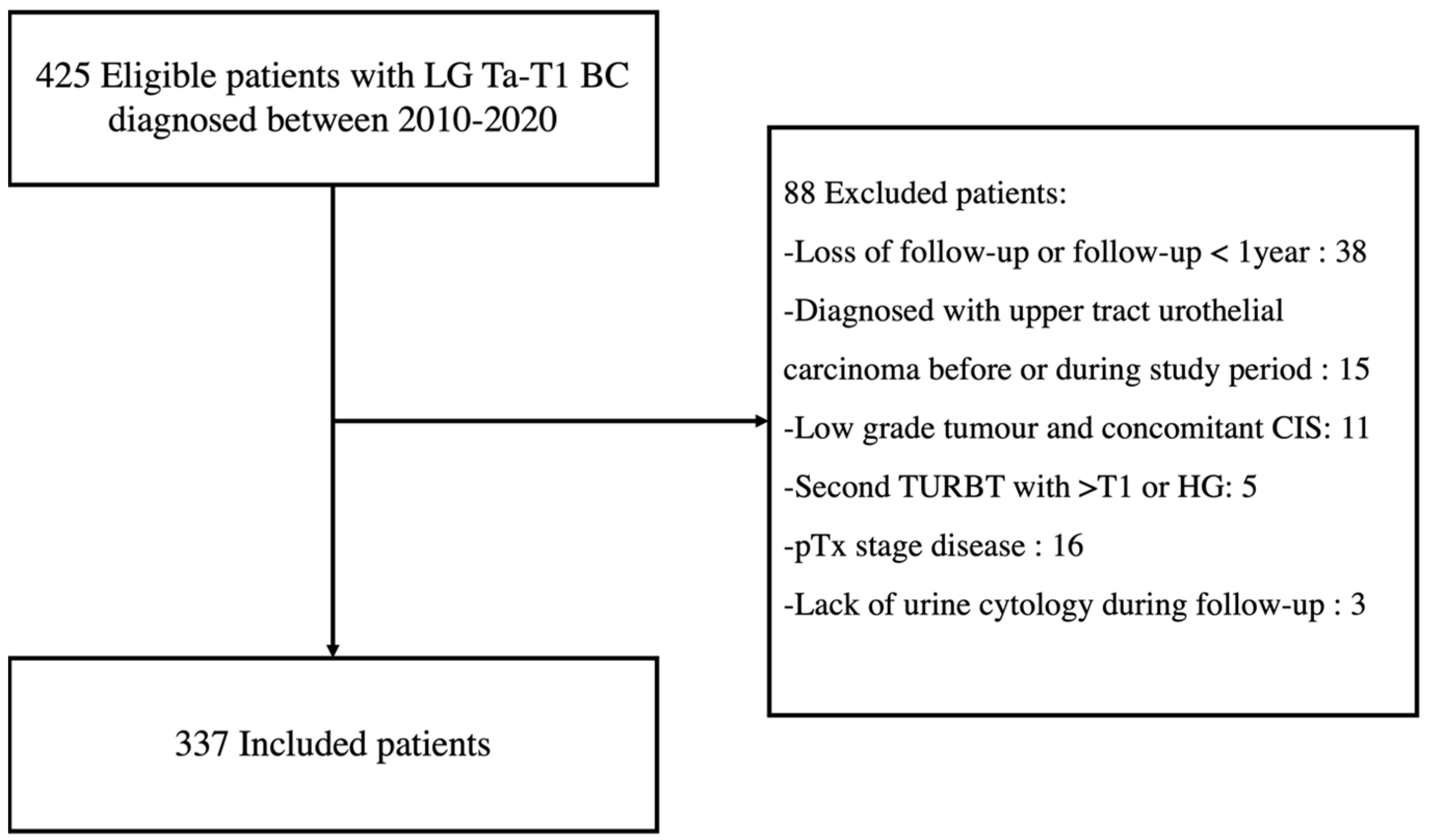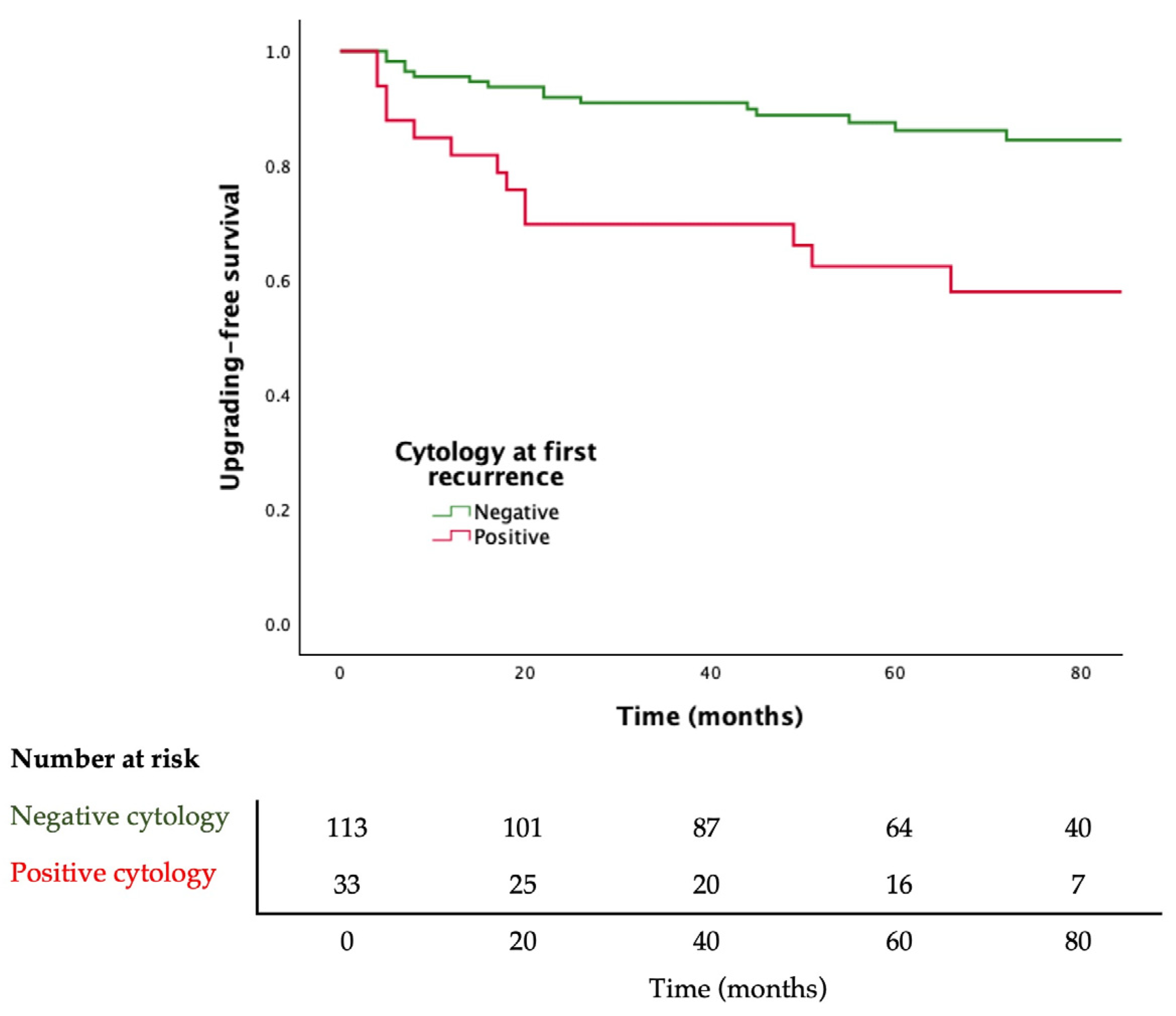The Role of Bladder-Washing Cytology as an Adjunctive Method to Cystoscopy During Follow-Up for Low-Grade TaT1 Non-Muscle-Invasive Bladder Cancer
Simple Summary
Abstract
1. Introduction
2. Materials and Methods
3. Results
3.1. Descriptive Characteristics
3.2. Recurrence Patterns and Predictive Value of Urine Cytology
3.3. Role of Bladder-Washing Cytology as an Adjunctive Method to Cystoscopy During Follow-Up of LG NMIBC
4. Discussion
5. Conclusions
Supplementary Materials
Author Contributions
Funding
Institutional Review Board Statement
Informed Consent Statement
Data Availability Statement
Conflicts of Interest
References
- Babjuk, M.; Burger, M.; Compérat, E.; Gontero, P.; Mostafid, A.H.; Palou, J.; Van Rhijn, B.W.G.; Rouprêt, M.; Shariat, S.F.; Sylvester, R.; et al. Non-muscle-invasive Bladder Cancer (TaT1 and CIS) EAU Guidelines. Eur. Urol. 2022, 31, 1–48. [Google Scholar]
- Chang, S.S.; Boorjian, S.A.; Chou, R.; Clark, P.E.; Daneshmand, S.; Konety, B.R.; Pruthi, R.; Quale, D.Z.; Ritch, C.R.; Seigne, J.D.; et al. Diagnosis and Treatment of Non-Muscle Invasive Bladder Cancer: AUA/SUO Guideline. J. Urol. 2016, 196, 1021–1029. [Google Scholar] [CrossRef] [PubMed]
- Soorojebally, Y.; Neuzillet, Y.; Roumiguié, M.; Lamy, P.J.; Allory, Y.; Descotes, F.; Ferlicot, S.; Kassab-Chahmi, D.; Oudard, S.; Rébillard, X.; et al. Urinary biomarkers for bladder cancer diagnosis and NMIBC follow-up: A systematic review. World J. Urol. 2023, 41, 345–359. [Google Scholar] [CrossRef] [PubMed]
- Yafi, F.A.; Brimo, F.; Steinberg, J.; Aprikian, A.G.; Tanguay, S.; Kassouf, W. Prospective analysis of sensitivity and specificity of urinary cytology and other urinary biomarkers for bladder cancer. Urol. Oncol. Semin. Orig. Investig. 2015, 33, 66.e25–66.e31. [Google Scholar] [CrossRef] [PubMed]
- Holmäng, S.; Hedelin, H.; Anderström, C.; Holmberg, E.; Busch, C.; Johansson, S.L. Recurrence and progression in low-grade papillary urothelial tumors. J. Urol. 1999, 162, 702–707. [Google Scholar] [CrossRef] [PubMed]
- Mariappan, P.; Smith, G.; Lamb, A.D.G.; Grigor, K.M.; Tolley, D.A. Pattern of Recurrence Changes in Noninvasive Bladder Tumors Observed During 2 Decades. J. Urol. 2007, 177, 867–875. [Google Scholar] [CrossRef] [PubMed]
- Bree, K.K.; Shan, Y.; Hensley, P.J.; Lobo, N.; Hu, C.; Tyler, D.S.; Chamie, K.; Kamat, A.M.; Williams, S.B. Management, Surveillance Patterns, and Costs Associated with Low-Grade Papillary Stage Ta Non-Muscle-Invasive Bladder Cancer among Older Adults, 2004–2013. JAMA Netw. Open 2022, 5, e223050. [Google Scholar] [CrossRef] [PubMed]
- Matulay, J.T.; Tabayoyong, W.; Duplisea, J.J.; Chang, C.; Daneshmand, S.; Gore, J.L.; Holzbeierlein, J.M.; Karsh, L.I.; Kim, S.P.; Konety, B.R.; et al. Variability in adherence to guidelines based management of nonmuscle invasive bladder cancer among Society of Urologic Oncology (SUO) members. Urol. Oncol. Semin. Orig. Investig. 2020, 38, 796.e1–796.e6. [Google Scholar] [CrossRef] [PubMed]
- Barkan, G.A.; Wojcik, E.M.; Nayar, R.; Savic-Prince, S.; Quek, M.L.; Kurtycz, D.F.I.; Rosenthal, D.L. The Paris System for Reporting Urinary Cytology: The Quest to Develop a Standardized Terminology. Acta Cytol. 2016, 60, 185–197. [Google Scholar] [CrossRef] [PubMed]
- Mowatt, G.; Zhu, S.; Kilonzo, M.; Boachie, C.; Fraser, C.; Griffiths, T.R.L.; N’Dow, J.; Nabi, G.; Cook, J.; Vale, L. Systematic review of the clinical effectiveness and cost-effectiveness of photodynamic diagnosis and urine biomarkers (FISH, ImmunoCyt, NMP22) and cytology for the detection and follow-up of bladder cancer. Health Technol. Assess. 2010, 14, 1–331. [Google Scholar] [CrossRef] [PubMed]
- Lotan, Y.; Roehrborn, C.G. Sensitivity and specificity of commonly available bladder tumor markers versus cytology: Results of a comprehensive literature review and meta-analyses. Urology 2003, 61, 109–118. [Google Scholar] [CrossRef] [PubMed]
- Van Rhijn, B.W.G.; Van Der Poel, H.G.; Van Der Kwast, T.H. Urine markers for bladder cancer surveillance: A systematic review. Eur. Urol. 2005, 47, 736–748. [Google Scholar] [CrossRef] [PubMed]
- Kobayashi, H.; Kikuchi, E.; Mikami, S.; Maeda, T.; Tanaka, N.; Miyajima, A.; Nakagawa, K.; Oya, M. Long term follow-up in patients with initially diagnosed low grade Ta non-muscle invasive bladder tumors: Tumor recurrence and worsening progression. BMC Urol. 2014, 14, 5. [Google Scholar] [CrossRef] [PubMed]
- Simon, M.; Bosset, P.O.; Rouanne, M.; Benhamou, S.; Radulescu, C.; Molinié, V.; Neuzillet, Y.; Paoletti, X.; Lebret, T. Multiple recurrences and risk of disease progression in patients with primary low-grade (TaG1) non–muscle-invasive bladder cancer and with low and intermediate EORTC-risk score. PLoS ONE 2019, 14, e0211721. [Google Scholar] [CrossRef] [PubMed]
- Feiertag, N.; Barry, E.; Abramson, M.; Park, J.Y.; Kovac, E.; Aboumohamed, A.; Watts, K.; Sankin, A. Urine Cytology Rarely Escalates Clinical Management in the Surveillance of Non–muscle-Invasive Bladder Cancer. Clin. Genitourin. Cancer 2023, 21, 258–264. [Google Scholar] [CrossRef] [PubMed]
- van der Aa, M.N.M.; Steyerberg, E.W.; Bangma, C.; van Rhijn, B.W.G.; Zwarthoff, E.C.; van der Kwast, T.H. Cystoscopy Revisited as the Gold Standard for Detecting Bladder Cancer Recurrence: Diagnostic Review Bias in the Randomized, Prospective CEFUB Trial. J. Urol. 2010, 183, 76–80. [Google Scholar] [CrossRef] [PubMed]
- Soukup, V.; Babjuk, M.; Bellmunt, J.; Dalbagni, G.; Giannarini, G.; Hakenberg, O.W.; Herr, H.; Lechevallier, E.; Ribal, M.J. Follow-up after surgical treatment of bladder cancer: A critical analysis of the literature. Eur. Urol. 2012, 62, 290–302. [Google Scholar] [CrossRef] [PubMed]
- Palou, J.; Brausi, M.; Catto, J.W.F. Management of Patients with Normal Cystoscopy but Positive Cytology or Urine Markers. Eur. Urol. Oncol. 2020, 3, 548–554. [Google Scholar] [CrossRef] [PubMed]
- Heney, N.M.; Ahmed, S.; Flanagan, M.J.; Frable, W.; Corder, M.P.; Hafermann, M.D.; Hawkins, I.R. Superficial bladder cancer: Progression and recurrence. J. Urol. 1983, 130, 1083–1086. [Google Scholar] [CrossRef] [PubMed]
- Bell, M.D.; Yafi, F.A.; Brimo, F.; Steinberg, J.; Aprikian, A.G.; Tanguay, S.; Kassouf, W. Prognostic value of urinary cytology and other biomarkers for recurrence and progression in bladder cancer: A prospective study. World J. Urol. 2016, 34, 1405–1409. [Google Scholar] [CrossRef] [PubMed]


| Variables | n = 337 |
|---|---|
| Age at diagnosis (years), median (IQR) | 68 (59–78) |
| Sex, n (%) | |
| Male | 268 (79.5) |
| Female | 69 (20.5) |
| Initial pT stage, n (%) | |
| Ta | 299 (88.7) |
| T1 | 38 (11.3) |
| EAU NMIBC prognostic factor risk group, n (%) | |
| Low-Risk | 262 (77.7) |
| Intermediate-Risk | 57 (16.9) |
| High-Risk | 18 (5.3) |
| Follow-up (years), median (IQR) | 5.0 (3.6–6.7) |
| Disease Recurrence, n (%) | 166 (49.3) |
| Variables | n = 166 |
|---|---|
| Age at recurrence (years), median (IQR) | 68 (59–78) |
| Sex, n (%) | |
| Male | 134 (80.7) |
| Female | 32 (19.3) |
| Initial pT stage, n (%) | |
| Ta | 147 (88.6) |
| T1 | 19 (11.4) |
| EAU NMIBC prognostic factor risk group, n (%) | |
| Low-Risk | 126 (75.9) |
| Intermediate-Risk | 31 (18.7) |
| High-Risk | 9 (5.4) |
| Time to Recurrence (months), median (IQR) | 12 (6–23) |
| Cystoscopy findings, n (%) | |
| Negative | 0 (0.0) |
| Suspicious lesion | 12 (7.2) |
| Positive | 154 (92.8) |
| Cytology results, n (%) | |
| Negative for UC | 104 (62.7) |
| Atypia | 9 (5.4) |
| Suspicious for UC | 20 (12.1) |
| Positive for UC | 13 (7.8) |
| Insufficient for diagnosis | 20 (12.0) |
| Cytology results grouped, n (%) | |
| Negative | 113 (68.1) |
| Positive | 33 (19.9) |
| Insufficient for diagnosis | 20 (12.0) |
| Patient Characteristics | Cystoscopy at Recurrence | Initial Management | Cytology | Management Change | Recurrence Pathology |
|---|---|---|---|---|---|
| Male 76 yo Debut LGT1 EAU High Risk | Suspicious area | Early cystoscopic control | Positive for HGUC | Biopsy of the suspected area + mapping biopsies | CIS |
| Male 69 yo Debut LGTa EAU Low Risk | Suspicious lesion | Early cystoscopic control | Positive for HGUC | Biopsy of the suspected area + mapping biopsies | CIS |
| Male 65 yo Debut LGTa EAU Low Risk | Suspicious papillary lesion | Outpatient appointment to check cytology result | Positive for HGUC | TURBT + bladder biopsies | HGTx + CIS |
Disclaimer/Publisher’s Note: The statements, opinions and data contained in all publications are solely those of the individual author(s) and contributor(s) and not of MDPI and/or the editor(s). MDPI and/or the editor(s) disclaim responsibility for any injury to people or property resulting from any ideas, methods, instructions or products referred to in the content. |
© 2024 by the authors. Licensee MDPI, Basel, Switzerland. This article is an open access article distributed under the terms and conditions of the Creative Commons Attribution (CC BY) license (https://creativecommons.org/licenses/by/4.0/).
Share and Cite
Carbonell, E.; Mercader, C.; Alfambra, H.; Narvaez, P.; Villalba, E.; Pagès, R.; Asiain, I.; Costa, M.; Franco, A.; Alcaraz, A.; et al. The Role of Bladder-Washing Cytology as an Adjunctive Method to Cystoscopy During Follow-Up for Low-Grade TaT1 Non-Muscle-Invasive Bladder Cancer. Cancers 2024, 16, 3708. https://doi.org/10.3390/cancers16213708
Carbonell E, Mercader C, Alfambra H, Narvaez P, Villalba E, Pagès R, Asiain I, Costa M, Franco A, Alcaraz A, et al. The Role of Bladder-Washing Cytology as an Adjunctive Method to Cystoscopy During Follow-Up for Low-Grade TaT1 Non-Muscle-Invasive Bladder Cancer. Cancers. 2024; 16(21):3708. https://doi.org/10.3390/cancers16213708
Chicago/Turabian StyleCarbonell, Enric, Clàudia Mercader, Héctor Alfambra, Paulette Narvaez, Eric Villalba, Rita Pagès, Ignacio Asiain, Meritxell Costa, Agustín Franco, Antonio Alcaraz, and et al. 2024. "The Role of Bladder-Washing Cytology as an Adjunctive Method to Cystoscopy During Follow-Up for Low-Grade TaT1 Non-Muscle-Invasive Bladder Cancer" Cancers 16, no. 21: 3708. https://doi.org/10.3390/cancers16213708
APA StyleCarbonell, E., Mercader, C., Alfambra, H., Narvaez, P., Villalba, E., Pagès, R., Asiain, I., Costa, M., Franco, A., Alcaraz, A., Ribal, M. J., & Vilaseca, A. (2024). The Role of Bladder-Washing Cytology as an Adjunctive Method to Cystoscopy During Follow-Up for Low-Grade TaT1 Non-Muscle-Invasive Bladder Cancer. Cancers, 16(21), 3708. https://doi.org/10.3390/cancers16213708







